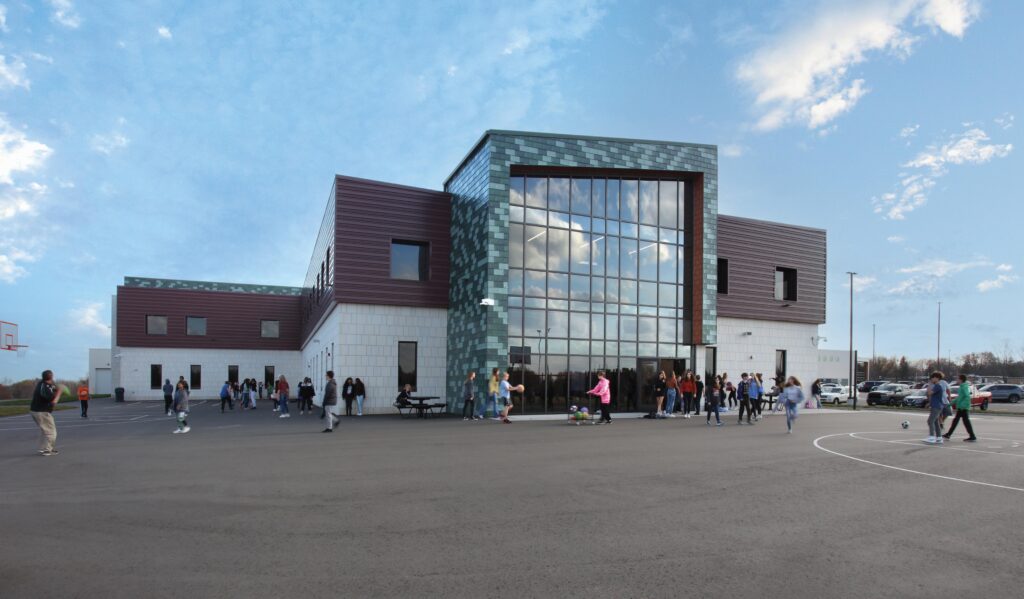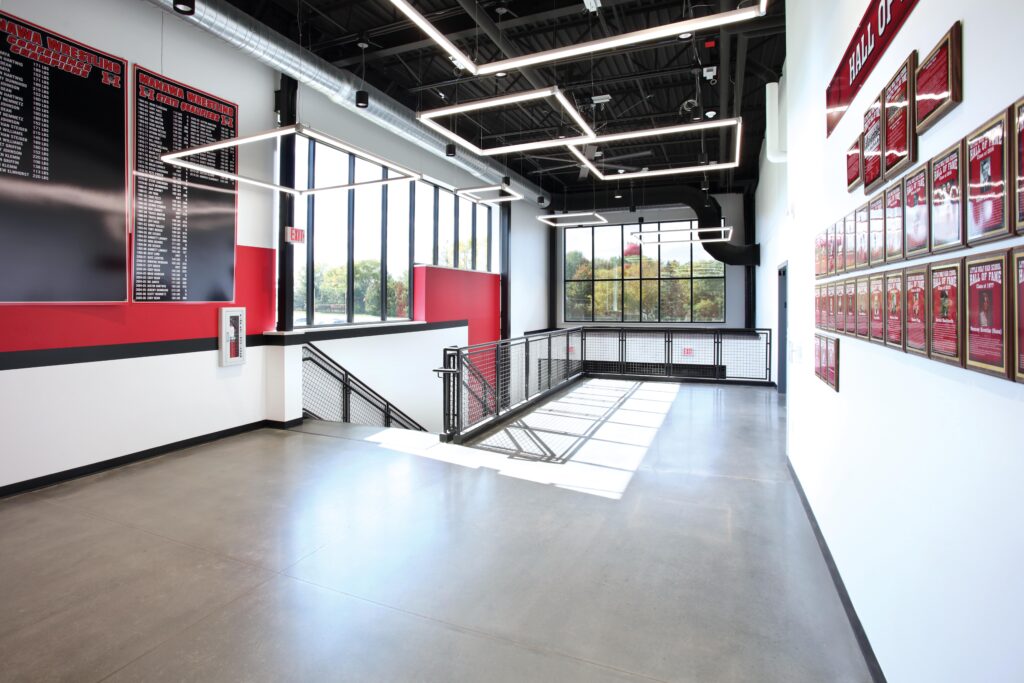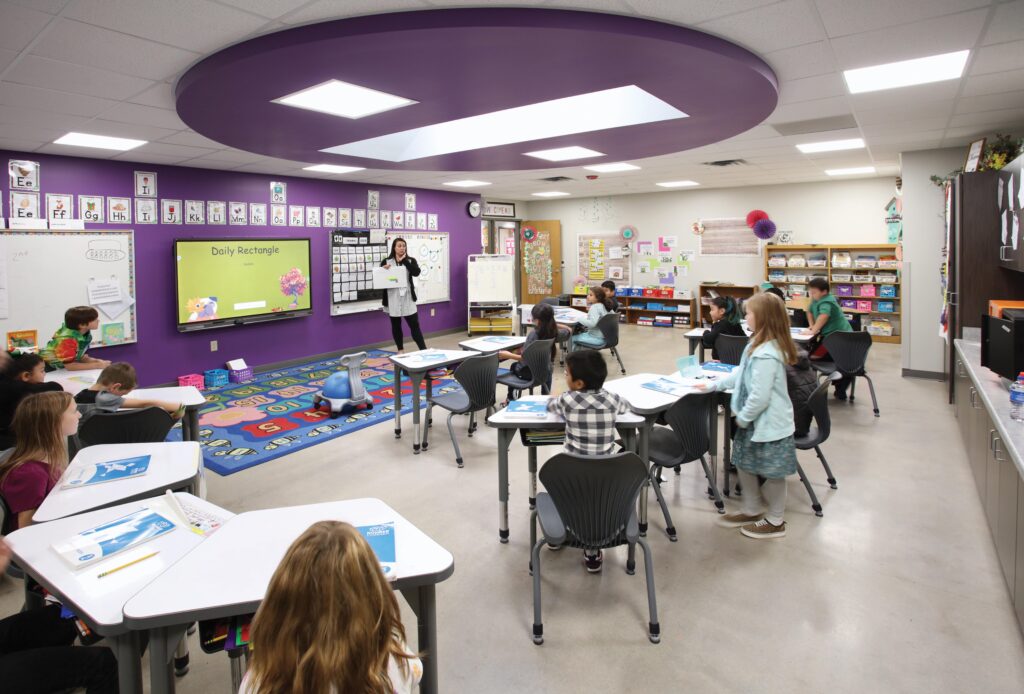The next big focus in the design, planning, and construction sector involves the integration of WELL building principles. This attention centers on prioritizing the welfare of occupants, which in our setting is students, teachers, staff, and visitors. The International WELL Building Institute (IWBI) is dedicated to reshaping health and well-being with a people-centric approach to buildings, organizations, and communities. IWBI offers a research-based roadmap which design professionals use to devise strategies for creating healthier environments in educational facilities. Within this article, we will present examples and provide an overview.

A HEALTHY EDUCATIONAL MODEL
Wisconsin’s Clintonville Public School District offers a prime example. A recent addition to their middle school incorporates an array of lighting-related features aimed at enhancing health and well-being. The new space meets WELL L01 and L02 standards related to lighting, as every occupied room provides natural light and ensures appropriate illuminance levels on work planes. Additional examples of daylighting integrated into the new facility include clerestory lighting and extensive glazing in the corridor. Another instance of meeting the WELL standards in this project is the inclusion of tunable lighting, allowing for control of color and brightness and facilitating adjustments in spaces such as the nurse/sick area and special education rooms. These measures satisfy the requirement related to “Occupant Lighting Control.”
A recent addition to their middle school incorporates an array of lighting-related features aimed at enhancing health and well-being.
WELL BUILDING CONCEPTS
The WELL Building Standard™ version 2 (WELL v2™) serves as a method for us to be more deliberate and purposeful about the construction and use of spaces. The standard draws upon the expertise of a diverse and robust community of WELL users, building experts, practitioners, and public health professionals worldwide. It brings together a blend of design solutions, operational strategies, and policies all grounded in the latest research aimed at improving our health.
Let’s delve deeper into the standards and practices integrated into WELL buildings:
• Lighting – This aspect advocates for exposure to light and aims to create well-lit environments that promote visual, biological, and mental health. This emphasis revolves around improving visual comfort, daylight exposure, and outdoor views, while reducing glare from electric lights and providing occupant lighting control.
• Mental Health – The WELL Mind aspect promotes mental health through strategies addressing a range of factors influencing cognitive and emotional well-being. Measures include promoting mental health awareness, incorporating natural environments, managing stress, and providing restorative opportunities, and spaces.

• Community Engagement – This involves building a culture of health that accommodates diverse population needs and fosters an inclusive, engaged occupant community. It promotes understanding of how building design, policies, and operations impact health and well-being through initiatives such as emergency preparedness, occupant surveys, support for new parents, and creating accessible, comfortable buildings for people of all abilities and backgrounds.
• Air Quality – The WELL Air concept strives to achieve elevated levels of indoor air quality throughout a building’s lifespan by using various strategies, including the elimination or reduction of pollutants. Concrete measures in this area include focusing on air quality, ventilation design, managing construction pollution, utilizing operable windows, and controlling mold and microbes.
• Nutrition – The WELL Nourishment concept encourages the establishment of environments where the healthiest choices are the easiest. This includes promoting informed food decisions, increasing fruit and vegetable consumption, avoiding highly processed ingredients, providing food messaging, and encouraging appropriate portion sizes.
• Water Quality – This concept encompasses aspects of water quality, distribution, and control within a facility. It addresses features that focus on accessibility and contaminant thresholds for drinking water, as well as managing water delivery systems to prevent negative impacts on building materials and the indoor environment. Issues such as water quality indicators, moisture management, hygiene support, and water conservation are included in the standards.
• Sound Environment – The WELL Sound initiative aims to enhance occupant health and well-being by identifying and mitigating acoustical issues that negatively impact occupant experiences. The detailed guidelines cover areas such as sound mapping, implementing sound barriers, managing reverberation time, using sound-reducing surfaces, promoting hearing health conservation, and employing enhanced audio devices.
• Thermal Comfort – The WELL Thermal Comfort aspect promotes human productivity and ensures maximum thermal comfort for all building users through improved HVAC system design and control, as well as meeting individual thermal preferences. Thermal comfort significantly influences human satisfaction in buildings, aiming for over 80% of occupants to perceive their environment as thermally acceptable through measures such as radiant heating and cooling systems, humidity control, and enhanced operable windows.
• Material Selection – This involves reducing human exposure to chemicals that may negatively impact health during the construction, remodeling, furnishing, and operation of buildings. Strategies include promoting ingredient disclosure, optimizing product composition to minimize impacts on human and environmental health, and encouraging the use of low-hazard cleaning products and practices.
• Physical Activity – The Movement concept focuses on fostering physical activity as part of daily life, integrating movement into the culture, buildings, and communities. Examples include increasing walkability, providing ergonomic workstations, promoting stair use, encouraging cycling to school, offering no-cost physical activity opportunities, and discouraging prolonged sitting.
• Innovation – This encourages stakeholders to develop strategies for creating healthier environments and rewards projects proposing substantive interventions addressing health and well-being. It also encourages the utilization of green building certification options.
Incorporating more contact with nature within our built environments has been shown to enhance attentional capacity, aid in recovery from illness and stress, and improve psychological well-being.
CONCENTRATING ON MENTAL HEALTH
Initiatives targeting the WELL Mind aspect yield benefits such as reduced depression, pain, stress, and anxiety. By increasing opportunities for spaces that promote restoration, and implementing mindfulness programs, we can significantly impact mental and physical well-being. Incorporating more contact with nature within our built environments has been shown to enhance attentional capacity, aid in recovery from illness and stress, and improve psychological well-being.
Proper incorporation of daylight into schools plays a crucial role in mental and physical health. Windows not only contribute to aesthetics but also bring in sunlight and provide views that can enhance academic performance and well-being, fostering a positive and comfortable learning environment. When considering new construction, strategic placement of buildings with an east-west orientation and south-facing windows is essential to maximize daylighting. Thoughtful selection of window products by the design team can control unwanted solar heat gains and losses, lighting levels, and glare.
Choosing LED lighting and utilizing it effectively can offer additional benefits. Tuning LED lights to align with circadian rhythms promotes healthier rest and waking cycles while reducing energy consumption. Using blue spectrum LED lighting in the morning has been found to increase alertness in children compared to exposure to dim light.

ENHANCING COGNITIVE FUNCTION
Another key focus of WELL buildings, particularly relevant to schools, is improving air quality to reduce respiratory illnesses and enhance cognitive function. By minimizing volatile organic compound (VOC) levels and increasing outdoor air supply, we can improve indoor air quality, resulting in higher test scores while reducing illness and related symptoms.
Achieving high indoor air quality (IAQ) involves using low- or no-VOC products specified for furniture, adhesives, paints, flooring systems, carpeting, and furniture. Implementing air supply systems that allow a high percentage of outside air in classrooms, offices, and other areas significantly improves IAQ.
While a new HVAC system is expected to provide better air quality, regular inspections and scheduled preventive maintenance are essential to maintain system efficiency over time. Consistent filter changes, condensation pan drainage, and keeping unit ventilators clear of obstructions contribute to a healthier environment. Regular cleaning of return registers, outdoor air intakes, and supply diffusers are also recommended practices. A healthier environment results in fewer absentee days for both students and staff.
Increasing the level of focus and intentionality on health can lead to reduced absenteeism, improved cognitive function, enhanced morale, and much more.
IMPROVING INTENTIONALITY
The Harvard Chan School of Public Health, with a spotlight on school buildings and student success, documents that by the time a student completes high school, each will have spent over 15,000 hours inside school facilities. It is probable that teachers and administrators will spend even more time in these environments if they work for over 13 years. It is vital for us to ensure that we are laying the groundwork for excellent learning and robust mental and physical health for all individuals who frequent our schools. Reducing or eliminating mold, air pollution, ambient noise, radon, asbestos, and inadequate lighting should be a primary focus.
When contemplating your next construction project, prioritize the physical and mental health of your students and staff. Increasing the level of focus and intentionality on health can lead to reduced absenteeism, improved cognitive function, enhanced morale, and much more. Take the initiative in constructing a school that consistently promotes wellness!

